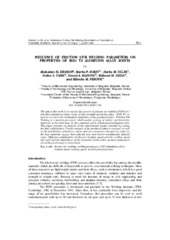Influence of friction stir welding parameters on properties of 2024 t3 aluminium alloy joints
Аутори
Eramah, Abdsalam M.Rakin, Marko

Veljić, Darko

Tadić, Srđan
Radović, Nenad

Zrilić, Milorad

Perović, Milenko
Чланак у часопису (Објављена верзија)
Метаподаци
Приказ свих података о документуАпстракт
The aim of this work is to analyse the process of friction stir welding (FSW) of 3 mm thick aluminium plates made of high strength aluminium alloy - 2024 T3, as well as to assess the mechanical properties of the produced joints. Friction Stir Welding is a modern procedure which enables joining of similar and dissimilar materials in the solid state, by the combined action of heat and mechanical work. This paper presents an analysis of the experimental results obtained by testing the butt welded joints. Tensile strength of the produced joints is assessed, as well as the distribution of hardness, micro-and macrostructure through the joints (in the base material, nugget, heat affected zone and thermo-mechanically affected zone). Different combinations of the tool rotation speed and the welding speed are used, and the dependence of the properties of the joints on these parameters of welding technology is determined.
Кључне речи:
friction stir welding / welding parameters / 2024 aluminium alloy / rotation speed / welding speed / welded joint propertiesИзвор:
Thermal Science, 2014, 18, S21-S28Издавач:
- Univerzitet u Beogradu - Institut za nuklearne nauke Vinča, Beograd
Финансирање / пројекти:
- Развој технологије производње и заваривања Ал-Мг легура високе чврстоће за примену у конструкцијама друмских и железничких транспортних средстава (RS-MESTD-Technological Development (TD or TR)-34018)
- Одрживост и унапређење машинских система у енергетици и транспорту применом форензичког инжењерства, еко и робуст дизајна (RS-MESTD-Technological Development (TD or TR)-35006)
DOI: 10.2298/TSCI130307170E
ISSN: 0354-9836
WoS: 000338690200004
Scopus: 2-s2.0-84907061101
Колекције
Институција/група
Tehnološko-metalurški fakultetTY - JOUR AU - Eramah, Abdsalam M. AU - Rakin, Marko AU - Veljić, Darko AU - Tadić, Srđan AU - Radović, Nenad AU - Zrilić, Milorad AU - Perović, Milenko PY - 2014 UR - http://TechnoRep.tmf.bg.ac.rs/handle/123456789/2676 AB - The aim of this work is to analyse the process of friction stir welding (FSW) of 3 mm thick aluminium plates made of high strength aluminium alloy - 2024 T3, as well as to assess the mechanical properties of the produced joints. Friction Stir Welding is a modern procedure which enables joining of similar and dissimilar materials in the solid state, by the combined action of heat and mechanical work. This paper presents an analysis of the experimental results obtained by testing the butt welded joints. Tensile strength of the produced joints is assessed, as well as the distribution of hardness, micro-and macrostructure through the joints (in the base material, nugget, heat affected zone and thermo-mechanically affected zone). Different combinations of the tool rotation speed and the welding speed are used, and the dependence of the properties of the joints on these parameters of welding technology is determined. PB - Univerzitet u Beogradu - Institut za nuklearne nauke Vinča, Beograd T2 - Thermal Science T1 - Influence of friction stir welding parameters on properties of 2024 t3 aluminium alloy joints EP - S28 SP - S21 VL - 18 DO - 10.2298/TSCI130307170E ER -
@article{
author = "Eramah, Abdsalam M. and Rakin, Marko and Veljić, Darko and Tadić, Srđan and Radović, Nenad and Zrilić, Milorad and Perović, Milenko",
year = "2014",
abstract = "The aim of this work is to analyse the process of friction stir welding (FSW) of 3 mm thick aluminium plates made of high strength aluminium alloy - 2024 T3, as well as to assess the mechanical properties of the produced joints. Friction Stir Welding is a modern procedure which enables joining of similar and dissimilar materials in the solid state, by the combined action of heat and mechanical work. This paper presents an analysis of the experimental results obtained by testing the butt welded joints. Tensile strength of the produced joints is assessed, as well as the distribution of hardness, micro-and macrostructure through the joints (in the base material, nugget, heat affected zone and thermo-mechanically affected zone). Different combinations of the tool rotation speed and the welding speed are used, and the dependence of the properties of the joints on these parameters of welding technology is determined.",
publisher = "Univerzitet u Beogradu - Institut za nuklearne nauke Vinča, Beograd",
journal = "Thermal Science",
title = "Influence of friction stir welding parameters on properties of 2024 t3 aluminium alloy joints",
pages = "S28-S21",
volume = "18",
doi = "10.2298/TSCI130307170E"
}
Eramah, A. M., Rakin, M., Veljić, D., Tadić, S., Radović, N., Zrilić, M.,& Perović, M.. (2014). Influence of friction stir welding parameters on properties of 2024 t3 aluminium alloy joints. in Thermal Science Univerzitet u Beogradu - Institut za nuklearne nauke Vinča, Beograd., 18, S21-S28. https://doi.org/10.2298/TSCI130307170E
Eramah AM, Rakin M, Veljić D, Tadić S, Radović N, Zrilić M, Perović M. Influence of friction stir welding parameters on properties of 2024 t3 aluminium alloy joints. in Thermal Science. 2014;18:S21-S28. doi:10.2298/TSCI130307170E .
Eramah, Abdsalam M., Rakin, Marko, Veljić, Darko, Tadić, Srđan, Radović, Nenad, Zrilić, Milorad, Perović, Milenko, "Influence of friction stir welding parameters on properties of 2024 t3 aluminium alloy joints" in Thermal Science, 18 (2014):S21-S28, https://doi.org/10.2298/TSCI130307170E . .


